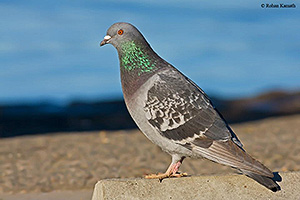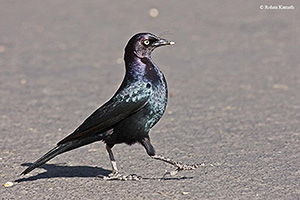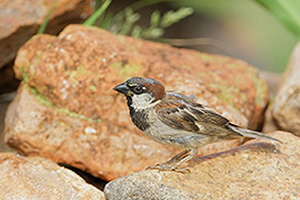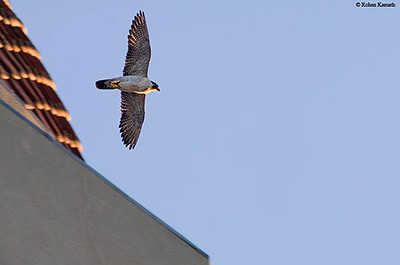Urban Birds |
|
|---|---|




photographs of a Rock Dove (top), a Brewer's Black-bird (2nd) and a Peregrine Falcon (bottom) by Rohan Kamath and a House Sparrow (3rd) by Tom Grey |
Referring
to an inner-city bird perched on a neglected dumpster as an
avian cockroach or feathered rat may well raise appreciative
nods. In fact, the ability of vast numbers of birds to make
their homes in cities regularly calls upon the ingenuity of
people to establish bird-free zones. This situation is not
restricted to North America. In Moscow, for example, to keep
Hooded Crows from sliding down renowned and easily scratched
gold-leaf on onion domes, recordings of falcons and Northern
Goshawks (the crow's major predators) were played and
trained falcons released. Animal rights activists
periodically disapprove of such niche-emptying efforts, but
when birds are in conflict with people, it is the avian
populations that are reduced and the human populations
appeased. But not all city dwellers consider urban birds as candidates for extermination. More and more people, in addition to those who enjoy feeding pigeons and sparrows in parks, are viewing their avian neighbors with interest. For birders who cannot often venture into a natural setting there is a wealth of avian activity to watch right in the city. Some urban birds become uncharacteristically tame and relatively simple to observe. It is easier, for example, to witness the maintenance of dominance hierarchies in slow-gaited city pigeons (Rock Doves) than in their fast-flying country cousins. Similarly, city crows, park ducks, outdoor restaurant House Sparrows, and parking lot Brewer's Blackbirds are more approachable than their rural brethren. The artificial concrete and steel ecosystems of cities, including occasional small, manicured parks, can support a surprisingly large number of birds. The birds are often most visible where people have congregated to buy, sell, eat, and discard food. The commensal relationship (whereby birds vacuum up bits of food that people do not value for themselves -- items dropped, discarded, or purposely provided) is evident near benches in city parks, in playgrounds, sports stadiums, and the parking lots of fast-food restaurants, at deserted farmers' markets and fairgrounds, around refuse disposal areas, and at window ledge feeders. Urban birds differ from wild populations in several ways, besides just being easier to observe. A number of ornithologists have looked at the ways birds have adapted to urban foraging. For example, in cities that lie in the snowbelt, birds may seek underground heating ducts over which plants can grow, and have also learned to feed in areas illuminated by artificial light where they can prolong their foraging schedule. In another case, although feral (country) pigeons usually eat twice a day, filling their crops at each session and digesting the food between the feeding bouts, city pigeons face a less predictable food supply, and are much more opportunistic, having a relatively irregular feeding schedule. |
|
Beyond foraging strategies,
however, we know little about other aspects of urban bird
behavior. Do different neighborhoods, for example, support
different dialects in House Sparrows? Do fluctuating
population sizes and uncertain resources cause changes in
avian behavior? Will, for example, group territoriality
eventually evolve so that gangs of grackles, European
Starlings, and blackbirds stake claims when the available
"turf" is limited? And how do fluctuations in the number of
city birds affect their avian predators? Domestic pigeons,
for example, are the favored prey of Peregrine Falcons. If
the number of pigeons is reduced, will Peregrines living
around urban areas resort to a different prey or suffer
substantial losses? In the 1940s a scarcity in feed led to
such a reduction in the German pigeon population and
resulted in a decline of Peregrines. As yet, however, no
parallel trends have been described or predicted in North
America. Urban habitats favor species that are less affected by toxic substances flowing through cities, that are better able to adapt to artificial light, to communicate over the noise of traffic and automation, to breed successfully on human built structures, and to rebound after city council decisions to decimate their populations. As more of the natural habitat of Earth is destroyed, urban birds will become more "typical" of our avifauna. As tongue-in-cheek evolutionists claim, birds may, indeed, be feathered dinosaurs. Many species of birds may soon follow the dinosaurs into extinction, but it seems likely that urban birds will be around as long as there are people to build cities. |
|
| SEE:
Helping to Conserve Birds -- Local Level;
Feeding Birds;
Dominance Hierarchies;
Population Dynamics;
Habitat Selection;
Commensal Feeding. Copyright ® 1988 by Paul R. Ehrlich, David S. Dobkin, and Darryl Wheye. |
|